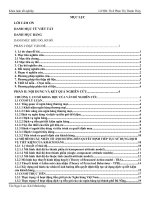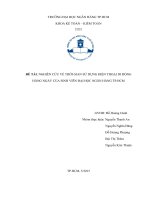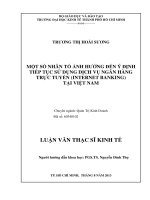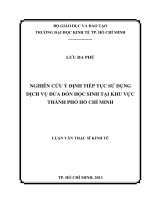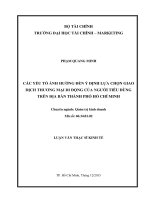Khía cạnh thời gian và ý định tiếp tục sử dụng thương mại di động vai trò của rủi ro cảm nhận và an toàn cảm nhận
Bạn đang xem bản rút gọn của tài liệu. Xem và tải ngay bản đầy đủ của tài liệu tại đây (872.39 KB, 177 trang )
MINISTRY OF EDUCATION AND TRAINING
UNIVERSITY OF ECONOMICS HO CHI MINH CITY
--------------------------------
NGUYEN HUU KHOI
TIME PERSPECTIVE AND CONTINUANCE INTENTION
TO USE MOBILE COMMERCE:
THE DUAL ROLE OF PERCEIVED RISK AND SECURITY
DISSERTATION
Ho Chi Minh city – 2020
MINISTRY OF EDUCATION AND TRAINING
UNIVERSITY OF ECONOMICS HO CHI MINH CITY
--------------------------------
NGUYEN HUU KHOI
TIME PERSPECTIVE AND CONTINUANCE INTENTION
TO USE MOBILE COMMERCE:
THE DUAL ROLE OF PERCEIVED RISK AND SECURITY
Major : Business administration
Code : 9340101
DISSERTATION
Academic advisors:
1. PROF. DR. NGUYỄN ĐÔNG PHONG
2. DR. LÊ NHẬT HẠNH
Ho Chi Minh city – 2020
1
DECLARATION OF AUTHENTICITY
This thesis is the result of work done during the period of registration and is
wholly the work of the author.
Nguyen Huu Khoi
2
ACKNOWLEDGMENTS
I would like to thank my first supervisor, Professor Nguyen Dong Phong, for
making me a better reader, a better thinker, and a better writer. I am also grateful to
my second supervisor Doctor Le Nhat Hanh for her challenging observations on my
ideas and proposals. Their constant guidance, invaluable suggestions and deep
insights in research have immensely shaped this thesis. This dissertation would
never have been written without their kind and patient assistance.
I am very grateful also to Doctor Ho Huy Tuu (Nha Trang University) and
Professor Svein Ottar Olsen (School of Business and Economics, UiT The Arctic
University of Norway) for their help with the valuable comments, suggestions, and
ideas.
I would also like to thank you to my colleagues and friends, who have given
encouragement and advice.
I am especially thankful to my wife, Thai Thi Hoai Thu, for her support and
understanding. The thesis is dedicated to my beloved parents who support me all
my life.
Nguyen Huu Khoi
TABLE OF CONTENT
Declaration of authenticity.........................................................................................i
Acknowledgments.....................................................................................................ii
3
Table of content........................................................................................................iii
List of abbreviations.................................................................................................vi
List of tables............................................................................................................vii
List of figures.........................................................................................................viii
Abstract.................................................................................................................... ix
CHAPTER 1 - INTRODUCTION.............................................................................1
1.1. Definition of key terms..........................................................................1
1.2. Research background.............................................................................3
1.3. Justification for the current research......................................................5
1.4. Research objectives and research questions...........................................8
1.5. Research methodology and scope..........................................................9
1.6. Research contributions.........................................................................10
1.7. Research structure................................................................................11
1.8. Research limitations.............................................................................12
1.9. Summary..............................................................................................13
CHAPTER 2 - LITERATURE REVIEW................................................................14
2.1. Mobile commerce and its advantages..................................................14
2.2. Continuance intention to use mobile commerce...................................17
2.3. Mobile commerce adoption in Vietnamese enterprises........................19
2.4. Previous studies on mobile commerce in a Vietnam and international
context................................................................................................................. 24
2.4.1. Previous studies on mobile commerce context in a Vietnam context 24
2.4.2. Previous studies on mobile commerce in an international context....32
2.4.3. Individual difference variables in mobile commerce research and
consideration of future consequences..................................................................41
2.4.4. Perceived risk and perceived security in mobile service adoption....44
2.5. Conclusion of the literature review......................................................46
2.6. The selection of Vietnam as a research context for the current study...47
2.7. Summary..............................................................................................49
4
CHAPTER 3 - HYPOTHESES DEVELOPMENT.................................................50
3.1.
Theoretical
frameworks
to
connect
consideration
of
future
consequences, perceived risk and security and continuance intention to use
mobile commerce................................................................................................50
3.1.1. Regulatory focus theory....................................................................50
3.1.2. Regulatory fit theory.........................................................................52
3.2. Research hypotheses and research model.............................................54
3.2.1.
Consideration
of
future
consequences-Immediate
versus
consideration of future consequences-Future......................................................54
3.2.2. Perceived risk vs security and continuance intention to adopt mobile
commerce
.....................................................................................................55
3.2.3. The relationships between time perspective and perceived risk versus
perceived security................................................................................................59
3.2.4. The moderating effects of CFCs........................................................60
3.2.5. Proposed research model and hypotheses.........................................63
3.3. Summary..............................................................................................64
CHAPTER 4 - RESEARCH METHOD..................................................................65
4.1. Research process..................................................................................65
4.2. Pilot study............................................................................................68
4.2.1. Questionnaire design.........................................................................68
4.2.2. Cronbach’s Alpha testing results.......................................................75
4.3. The main study.....................................................................................86
4.3.1. Data collection..................................................................................86
4.3.2. Data analysis method........................................................................90
4.4. Summary..............................................................................................93
CHAPTER 5 - DATA ANALYSIS AND RESULTS................................................95
5.1. Validation of measures: reliability and validity....................................95
5.1.1. First-order and reflective – reflective second-order constructs.........95
5.1.2. Reflective - formative second-order construct................................104
5
5.2. Checking for common method bias....................................................105
5.3. The strategy for testing the proposed moderating effects...................106
5.3.1. Product indicator approach..............................................................106
5.3.2. Orthogonalizing approach...............................................................106
5.3.3. Two-stage approach.........................................................................107
5.3.4. Justification for selecting the two-state approach in the current study. .
...................................................................................................108
5.4. Testing hypotheses by applying PLS-SEM........................................108
5.4.1. Research model quality...................................................................109
5.4.2. The direct effects.............................................................................109
5.4.3. The moderating effects....................................................................110
5.4.4. Testing for asymmetric impact........................................................111
5.4.5. Post-hoc analysis.............................................................................112
5.4.6. The summarization of hypothesis testing results.............................113
5.5. Hypothesis testing results summary...................................................115
5.6. Discussion..........................................................................................117
5.7. Summary............................................................................................120
CHAPTER 6 - CONCLUSIONS AND IMPLICATIONS.....................................121
6.1. Conclusion.........................................................................................121
6.2. Theoretical implications.....................................................................121
6.3. Practical implications.........................................................................127
6.4. Limitations and future research..........................................................129
6.5. Summary............................................................................................130
List of author’s published papers...............................................................................1
REFERENCES..........................................................................................................3
APPENDICES.........................................................................................................27
6
LIST OF ABBREVIATIONS
CFC
CFC-Future
CFC-Immediate
CMB
DTPB
EC
IDT
MC
MISS
PLS-SEM
SCT
PR
PS
TAM
TTF
TPB
TRA
Consideration of future consequences
Consideration of future consequences - Future
Consideration of future consequences - Immediate
Common method bias
Decomposed Theory of Planned Behavior
Electronic commerce
Innovation diffusion theory
Mobile commerce
Information systems success
Partial least square structural equation modeling
Social cognitive theory
Perceived risk
Perceived security
Technology acceptance model
Task – technology fit
Theory of planned behavior
Theory of reasoned action
The unified theory of acceptance and use of
UTAUT
technology
The extended unified theory of acceptance and use of
UTAUT2
VIF
technology
Variance inflation factor
7
LIST OF TABLES
Table 1-1: Definition of key terms used in the present research................................1
Table 2-1: Mobile commerce advantages over electronic commerce......................15
Table 2-2: Previous studies on mobile commerce in a Vietnam context..................25
Table 2-3: Some widely adopted theories of adoption.............................................33
Table 3-1: The summary of regulatory focus theory................................................51
Table 3-2: Summarization of proposed hypotheses.................................................63
Table 4-1: Constructs measurement.........................................................................70
Table 4-2: Cronbach's Alpha testing results.............................................................76
Table 4-3: Final items of the questionnaire..............................................................82
Table 4-4: Respondents' characteristic.....................................................................89
Table 5-1: Cronbach's Alpha and composite reliability...........................................96
Table 5-2: Factor loadings and average variance extracted......................................97
Table 5-3: Fornell-Larcker and Heterotrait-Monotrait criterion.............................103
Table 5-4: Convergent testing results of reflective-formative second-order construct
............................................................................................................................... 105
Table 5-5: The direct effect testing results.............................................................109
Table 5-6: The moderating effect testing results....................................................110
Table 5-7: Testing the relative importance of direct effects...................................111
Table 5-8: ANOVA analysis results........................................................................112
Table 5-9: Summary of path analysis testing results..............................................114
Table 5-10: Summary of hypothesis testing results................................................115
8
LIST OF FIGURES
Figure 2-1: Comparison between mobile commerce and other types of commerce.15
Figure 2-2: Websites with a mobile version.............................................................20
Figure 2-3: Enterprises with a mobile application for doing business.....................21
Figure 2-4: Average time-on-site of customers on the mobile versions of websites 21
Figure 2-5: Percentage of enterprises with a mobile application to support............22
Figure 2-6: Forms of advertising on websites/mobile applications..........................22
Figure 2-7: Advertising expenditure of the five cities..............................................23
Figure 2-8: Evaluation of the effectiveness of online advertising forms..................23
Figure 3-1: Regulatory fit between individual focus and risk vs security perception
................................................................................................................................. 53
Figure 3-2: Proposed research model......................................................................64
Figure 4-1: Research process diagram.....................................................................67
Figure 5-1: The reflective - reflective second-order construct of perceived risk. . .104
Figure 5-2: The reflective - formative second-order construct of perceived security
............................................................................................................................... 104
Figure 5-3: Path analysis results (without lower-order constructs)........................116
Figure 5-4: Path analysis results (with lower-order constructs).............................117
9
ABSTRACT
This study investigates how a specific domain consideration of future
consequences i.e., consideration of future consequences-Immediate (CFCImmediate) and consideration of future consequences-Future (CFC-Future)
asymmetrically associate and interact with perceived risk and perceived security as
trade-off constructs in predicting continuance intention to use mobile commerce.
Based on a self-administered survey data set of 441 Vietnamese consumers, partial
least square structural equation modeling is used to test the hypotheses. The results
show that CFC-Immediate and CFC-Future are important in explaining continuance
intention to use mobile commerce, but their roles are different due to the
asymmetric impact on perceived risk versus perceived security as well as their
moderating effects on the perceived risk, security and continuance intention. This
study is unique since it explores the different roles of CFC-Immediate and CFCFuture in explaining continuance intention to use mobile commerce under the tradeoff role of perceived risk versus perceived security.
Keywords: Consideration of future consequences; perceived risk and security;
continuance intention; direct, asymmetric and moderating effects.
TÓM TẮT
Luận án này nghiên cứu cách thức biến số xem xét kết quả trong tương lai
trong bối cảnh thương mại di động, cụ thể hơn là xem xét kết quả tương lai trong
ngắn hạn (CFC-Immediate) và xem xét kết quả tương lại trong dài hạn (CFCFuture) tác động bất đối xứng đến rủi ro cảm nhận và an toàn cảm nhận cũng như
tương tác với các biến số này trong việc dự báo ý định tiếp tục sử dụng thương mại
di động. Dựa trên một mẫu khảo sát tự quản lý gồm 441 người tiêu dùng Việt Nam,
phương pháp mô hình cấu trúc tối thiểu bán phần được sử dụng để kiểm định giả
thuyết. Kết quả cho thấy CFC-Immediate và CFC-Future có vài trò quan trọng trong
việc giải thích ý định tiếp tục sử dụng thương mại di động, nhưng vai trò mỗi biến
số là khác nhau do tác động bất đối xứng đến đến rủi ro cảm nhận và an toàn cảm
nhận cũng tác động điều tiết lên mối quan hệ giữa rủi ro cảm nhận, an toàn cảm
10
nhận và ý định tiếp tục sử dụng thương mại di động. Luận án có những đóng góp
quan trọng trong việc khám phá tác động của CFC-Immediate và CFC-Future đến ý
định tiếp tục sử dụng thương mại di động dưới sự đánh đổi về cảm nhận giữa của
rủi ro cảm nhận và an toàn cảm nhận.
Từ khóa: Xem xét kết quả trong tương lai; rủi ro cảm nhận và an toàn cảm nhận; ý
định tiếp tục; tác động trực tiếp, bất đối xứng và điều tiết.
1
CHAPTER 1 - INTRODUCTION
This chapter aims to introduce the research background and to present research
gaps. Accordingly, the literature review demonstrates that there still a lack of studies
that simultaneously investigates both risk and security to form more comprehensive
pictures of if and how opposite determinants are related to continuance intention to use
mobile commerce. This literature review additionally demonstrates the need to
investigate continuance intention to adopt MC from the perspective of consideration of
future consequences. Based on the identified research gap, this chapter postulates four
research objectives and four corresponding research questions. Next, research
methodology and scope are described. Finally, four expected research contributions are
introduced in academic and practical ways.
1.1. Definition of key terms
Table 1-1 postulates key terms used in the current studies as well as their
definition and source(s)
Table 1-1: Definition of key terms used in the present research
Key terms
Mobile commerce
Consideration of
future consequences
Consideration of
future consequencesImmediate
Consideration of
future consequencesFuture
Definition
Mobile commerce is considered
as conducting transactions on mobile
devices (smartphone, tablets) via
wireless connections such as mobile
internet (e.g., 3G, 4G) or wireless
internet
An
individual
differences
characteristic reflecting the extent to
which people consider the potential
distant outcomes of their current
behaviors and are influenced by those
potential outcomes
Consideration
of
future
consequences scale contains questions
tapping concern with immediate
consequences
Consideration
of
future
consequences scale contains questions
tapping
concern
with
future
Source(s)
Khoi, Tuu
and
Olsen
(2018)
Strathman,
Gleicher,
Boninger
and
Edwards (1994)
Joireman,
Balliet, Sprott,
Spangenberg
and
Schultz
(2008)
2
Key terms
Perceived risk
Perceived
security
Definition
Source(s)
consequences
Perceived risk is defined as
Featherma
potential negative outcomes or losses of n and Pavlou
a decision to use mobile commerce
(2003),
Kim,
Ferrin and Rao
(2008), Luo, Li,
Zhang and Shim
(2010)
Perceived security is defined as
Cheung
positive results of safety process and and Lee (2006),
store transaction information in relation Hartono,
to using mobile commerce
Holsapple, Kim,
Na and Simpson
(2014, p. 12),
Kim, Tao, Shin
and
Kim
(2010b)
Continuance
Continuance intention is defined
Chong
intention to use mobile as an individual’s subjective probability (2015)
commerce
that a consumer will continue using
mobile commerce
(Source: author’s summarization)
1.2. Research background
Previous studies have considered the significant evolvement of mobile devices
and mobile internet technologies in recent year (Hanafizadeh, Behboudi, Koshksaray
and Tabar, 2014, Malaquias and Hwang, 2016) as an important facilitator of the
development and proliferation of mobile applications and mobile business (Celik,
2016, Lu, 2014). As a result, mobile commerce has emerged as an alternative and
modern type of shopping among consumers (Khoi et al., 2018, Phong, Khoi and Le,
2018, Shao, Zhang, Li and Guo, 2019). Because mobile commerce use mobile devices
and wireless internet connection, the key benefits of this modern type of commerces
are ubiquity, accessibility, convenience, localization, instant connectivity, time
sensitivity and security (Anil, Ting, Moe and Jonathan, 2003, Nassuora, 2013,
Sanakulov and Karjaluoto, 2015, Zhang, Zhu and Liu, 2012). Also, mobile commerce
3
is faster, more powerful and more effective than computer-based e-commerce (Hsieh,
2014).
With no exception, the development of mobile commerce depends on the
attraction of new consumers (Ovčjak, Heričko and Polančič, 2015, Sanakulov and
Karjaluoto, 2015, Zhang et al., 2012). This issue also attracts the interest of academia
all over the world. Indeed, previous studies have revealed that one of the main topics is
what determinants of customer intention to use this modern type of shopping. Previous
studies have categorized online shopping into mobile commerce, electronic commerce,
social commerce and Facebook commerce (Khoi et al., 2018, Lam, Yeung, Lo and
Cheng, 2019, Wu, Shen and Chang, 2015). While mobile commerce refers to
conducting transactions on mobile devices, electronic commerce is defined as
conducting an online transaction via the Internet in a computer-mediated environment
(Vladimir, 1996), social commerce can be seen as a subset of electronic commerce that
includes conducting various types of commercial activities on social media (Lam et al.,
2019) such as Facebook, Twitter. As such Facebook commerce is social commerce that
is conducted in a specific social network of Facebook (Chen, Su and Widjaja, 2016).
With the increasing competition between mobile commerce and other types of
commerce, maintaining existing consumers seems to be more effective and efficient
(Yuan, Liu, Yao and Liu, 2014, Zhou, 2013c, Zhou, 2013e, Zhou, 2014).
In other words, nurturing and fostering continuance intention of mobile
commerce use also is a significant issue to discover (Bhattacherjee, Perols and
Sanford, 2015, Yuan et al., 2014, Zhou, 2014). However, previous studies in a mobile
commerce context mainly focus on initial adoption while continuance adoption or
repurchase loyalty receives less attention and interest (Shao et al., 2019, Zhou, 2014).
Also, prior studies have largely adopted technology’s characteristics driving factors
that are derived from well-established models such as the technology acceptance
model (TAM; Davis, 1989), innovation diffusion theory (IDT; Rogers, 1995) and the
unified theory of acceptance and usage of technology (UATUT; Venkatesh, Morris,
Davis and Davis, 2003) to increase the predictive power of models explaining and
predicting consumer continuance intention to use mobile commerce (Shao et al., 2019,
4
Zhou, 2013b, Zhou, 2013e, Zhou, 2014). Most of prior research focus on either
promotion or barrier factors, for example, Chong (2015) adopts two constructs of
technology acceptance model, which are perceived usefulness and perceived ease of
use, to explain an increase in continuance intention to use mobile commerce while
Zhou (2014) uses two variables (i.e., Information quality and system quality) derived
from the model of information system success to explain a decrease in continuance
usage of mobile payment. However, there still a lack of studies that simultaneously
investigates both promotion and barrier factors, for example risk and security to form a
more comprehensive pictures of if and how opposite determinants are related to
continuance intention to use mobile commerce (Hanafizadeh et al., 2014, Malaquias
and Hwang, 2016, Phong et al., 2018). From the practical perspective, those
understanding provide policy makers and companies with insights into the
development of appropriate marketing strategies to promote the mobile commerce
services use (Hsieh, 2014).
Furthermore, previous studies have documented that consumer behavior is
affected by individual differences (Hong, Lin and Hsieh, 2017, Mohamed, Hussein,
Hidayah Ahmad Zamzuri and Haghshenas, 2014, Wang, Ngai and Wei, 2012). In
general, individual difference factors have been extensively divided into personality,
cognitive style, and demographic/situational variables (Hirschberg, 1978). Among
them, personality traits are stable characteristics that have important roles in
explaining behavior (Liu, Zhao, Chau and Tang, 2015). Personality traits such as Big
Five and personal values, perceived values, risk-taking propensity, personal
innovativeness are adopted to explain continuance to use innovative products and
services (Hong et al., 2017, Mohamed et al., 2014, Wang et al., 2012). However, time
perspective - one personality traits factor that have potential to explain behavioral
continuance intention – is largely ignored in a mobile commerce context (Joireman
and King, 2016). From the academic perspective, the investigating of if and how time
perspective is related to continuance intention to use mobile commerce contributes to
the understanding of the relationship between personality traits and behavioral
5
intention while from the practical aspect, this understanding would provide managers
with more insights into consumer segmenting and targeting (Olsen and Tuu, 2017,
Pozolotina and Olsen, 2019).
1.3. Justification for the current research
Consideration of future consequences CFC is defined as the extent to which
individuals consider the potential distant outcomes (i.e., immediate and future
benefits) of their current behaviors and the extent to which they are influenced by
these potential outcomes (Strathman et al., 1994). Most previous studies also adapt the
conceptualization and operationalization of CFC including two distinct factors, which
are CFC-Immediate and CFC-Future (Arnocky, Milfont and Nicol, 2013, Joireman,
Shaffer, Balliet and Strathman, 2012, Olsen and Tuu, 2017). Recently well-established
studies in different areas such as food behaviors (Dassen, Houben and Jansen, 2015,
Dassen, Jansen, Nederkoorn and Houben, 2016, Olsen and Tuu, 2017) or proenvironmental behaviors (Arnocky et al., 2013, Joireman et al., 2012, van Beek,
Antonides and Handgraaf, 2013) have focused on consumers’ time perspective to
generate interventions toward expected outcomes for both individuals and societies.
Also, previous studies suggest that CFC can be regarded as a domain-specific concept
since individuals can be time-oriented in some spheres of life, but not in others
(McKay, Perry, Cole and Magee, 2017, Olsen and Tuu, 2017, van Beek et al., 2013).
Furthermore, CFC has been largely ignored in mobile commerce context. Therefore,
while in responding to a call for research on the unique contributions of CFCImmediate and CFC-Future (Joireman et al., 2008, Joireman and King, 2016), the
current research also contributes the the exisiting literature by extending the two-factor
structure of CFC into a domain-specific immediate and future time perspective of a
new context of mobile commerce.
Consumers’ continuance intention to use mobile commerce is an important
behavior that has attracted substantial attention from both e-commerce academia and
practitioners (Lin and Shih, 2008, Shao et al., 2019, Zhou, 2011). It is defined as an
individual’s subjective probability to continue using mobile commerce (Bhattacherjee,
6
2001a, Bhattacherjee et al., 2015). Continuance intention to use mobile commerce
could reflect a consideration of a trade-off between focusing on negative results/risk
(e.g., monetary loss, status loss, privacy threat) versus emphasizing positive
outcomes/security (e.g., service personalization, convenience, secured financial
transaction) (Ashraf, Razzaque and Thongpapanl, 2016, Kalinic and Marinkovic,
2015) that depend on individual differences regarding their immediate and future
perspectives (Joireman et al., 2008, Joireman, Kees and Sprott, 2010, Joireman et al.,
2012, Joireman, Strathman and Balliet, 2006, Olsen and Tuu, 2017). Therefore, this
study helps to respond to a call for filling the gaps in exploring individual differences
to predict consumer behaviors in mobile commerce context (Ovčjak et al., 2015,
Sanakulov and Karjaluoto, 2015, Zhang et al., 2012). Particularly, the relative role of
CFC-Immediate and CFC-Future in relation with perceived risk and perceived
security, to predict consumer continuance intention to use mobile commerce is
investigated in the current study. A knowledge on how to shift consumers from a focus
on immediate benefits and negative/risk perceptions to an emphasis on future benefits
and positive/security perspective can be important for developing effective messages
to convince consumers in increasing mobile commerce usage.
Both perceived risk and perceived security are important constructs in consumer
literature, particularly in a mobile commerce area (Flavián and Guinalíu, 2006,
Hartono et al., 2014, Schierz, Schilke and Wirtz, 2010). While perceived risk has long
been defined as negative perceptions and losses (Ovčjak et al., 2015, Sanakulov and
Karjaluoto, 2015, Zhang et al., 2012), perceived security has emerged to be understood
as positive cognitions and potential prospect of online services (Flavián and Guinalíu,
2006, Hartono et al., 2014, Schierz et al., 2010). According to the regulatory focus
theory (Higgins, 1997), perceived risk is considered to be closely associated with
prevention focus (Ovčjak et al., 2015, Sanakulov and Karjaluoto, 2015, Zhang et al.,
2012), while perceived security is usually connected to promotion focus (Flavián and
Guinalíu, 2006, Hartono et al., 2014, Schierz et al., 2010, Shin, 2009). Since
individuals with CFC-Immediate tend to focus more on losses, negative results,
7
pessimistic thoughts and prevention orientation, while those with CFC-Future tend to
focus on gains, positive consequences, optimistic thoughts and promotion orientation
as guides for their current actions (Joireman et al., 2012), CFC-Immediate and CFCFuture may have asymmetric effects on perceived risk versus perceived security.
Therefore, this study makes an effort to extend the previous studies on CFCs (e.g.,
Olsen and Tuu, 2017) in a mobile commerce context by exploring if and why both
CFC-Immediate and CFC-Future can asymmetrically influence perceived risk and
perceived security. The investigation of asymmetric impacts of CFC-Immediate and
CFC-Future on both perceived risk and perceived security is expected to provide a
deeper insight into how to consolidate positive benefits and to weaken negative
perceptions or losses to promote consumers’ expected behaviors (e.g., Olsen and Tuu,
2017).
Furthermore, it is more likely that CFC-Immediate better fits with perceived risk
than with perceived security while CFC-Future is more congruent with perceived
security than perceived risk (Aaker and Lee, 2006, Higgins, 1997, Higgins, Friedman,
Harlow, Idson, Ayduk and Taylor, 2001). Therefore, CFC-Immediate would make
consumers become more and less sensitive to risk and security respectively,
meanwhile, consumers with CFC-Future tend to be less sensitive to risk and more
sensitive to security. This implies CFC-Immediate and CFC-Future could have
contradicting interactions with perceived risk and security to influence behavioral
consequences (c.f. Kees, Burton and Tangari, 2010, Strathman et al., 1994). For this
reason, this study goes a further step to explore these moderating effects to give a more
comprehensive picture of if and why CFC can interact with perceived risk and security
to impact on continuance intention to use mobile commerce. A more comprehensive
understanding of perceived risk and perceived security is also provided by structuring
those two constructs as reflective second-order construct versus formative secondorder construct (Hartono et al., 2014, Park and Tussyadiah, 2016).
This study has some important contributions by combining CFC-Immediate and
CFC-Future with perceived risk and perceived security to explain consumer
8
continuance intention to use mobile commerce by answering some ignored questions
in a mobile commerce context. By addressing these questions, this study contributes to
the body of knowledge regarding the different effects of an important individual
difference characteristic (CFC) on risk vs security trade-off and behavioral intention
and thus, provide some implications for improving mobile commerce adoption. From
the practical perspective, this study provides managers with significant insights of how
to develop and promote mobile commerce in Vietnam.
1.4. Research objectives and research questions
The general objective of this work is to extends previous findings of Joireman et
al. (2012) and Olsen and Tuu (2017) in (un)healthy behavior domain into mobile
commerce context to test the simultaneous impact of risk vs security on continuance
intention to use mobile commerce under the influence of consideration of future
consequences. Accordingly, the specific objectives of this research are:
Objective 1: This study aims at testing the simultaneously direct influence of
consideration of future consequences – immediate and consideration of future
consequences of future consequences – future on continuance intention to use mobile
commerce.
Objective 2: This study aims at testing the simultaneous impact of perceived risk
and security on consumer continuance intention to use mobile commerce.
Objective 3: This study aims to test the simultaneous and different (asymmetric)
influences of consideration of future consequences – immediate and consideration of
future consequences of future consequences – future on the perception of risk and
security
Objective 4: This study aims to discuss and test if and how consideration of
future consequences - immediate and consideration of future consequences - future
interact with the perception of security and risk to influence continuance intention to
use mobile commerce.
In order to achieve the above objectives, this research postulates four
corresponding research questions as follows:
9
Question 1: What is the mechanism through which CFCs simultaneously and
directly affect continuance intention to use mobile commerce?
Question 2: What is the mechanism through which perception of risk and security
jointly influence continuance intention to adopt mobile commerce?
Question 3: What is the mechanism through which CFCs have simultaneously
and differently effects on the perception of risk and security?
Question 4: What is the mechanism through which CFC-Future buffers
(weakens) the security (risk) – continuance intention while CFC-Immediate
strengthens (dampens) the risk (security) – continuance intention relationship?
1.5. Research methodology and scope
This research is divided into two studies: the pilot study and the main study. The
pilot study is conducted in order to refine the instrument (i.e., the questionnaire) with
regard to arrangement, wording accuracy, and relevance. The main study aims at
ensuring the reliability, convergent validity, discriminant validity of construct
measurements as well as testing the proposed hypotheses.
Cronbach’s Alpha test is adopted in the pilot while in the main studies, the
convergent and discriminant validity of measurements are assessed and the proposed
hypotheses, including direct, moderating and relative important hypotheses are tested
using SmartPLS 3.2.8.
Since we investigated consumers’ continuance intention to use mobile commerce,
it was necessary that respondents should have a mobile phone, use mobile internet
services (e.g., 4G) and have used mobile commerce before. Thus, respondents are
customers of the three biggest communication service providers in Vietnam (VNPT,
Mobifone, and Viettel). They are selected by asking a screening question in order to
ensure they have used mobile commerce before. Data is collected in a selfadministered survey and a questionnaire takes about 10-20 minutes to complete.
1.6. Research contributions
This research is expected to have some significant contributions in both academic
and practical ways.
10
Firstly, it is anticipated that this study contributes to the deeper and broader
understanding of if and how the facilitator and barrier simultaneously influence and
explain continuance intention to use mobile commerce. This study contrasts the impact
of perception of risk and security on consumer behavioral intention. While risk is
widely investigated, security is an emerging factor in a mobile commerce context.
Thus, it is argued that the research results will attract more attention of researchers to
discover and examine emerging factors as well as compares the effects between
opposite determinants. From the practical perspective, the research results provide
managers with more tools to foster positive impact while weakening negative impact
on continuance intention to use mobile commerce.
Secondly, this study is expected to contribute to the mobile commerce literature
by proposing and confirming the role of an emerging individual differences factor –
consideration of future consequences – in explaining and predicting continuance
intention to use mobile commerce. The results are anticipated that while confirms the
two underlying factors of consideration of future consequences, also provided
additional insight into if and how individual differences in consideration of future
consequences relate to continuance intention to use mobile commerce. The impact of
this variable on continuance intention to use mobile commerce should be covered in
future studies since it is considered as a promising factor in explaining consumer
behavior in prior studies. In terms of managerial implication, the research results
provide a guide for managers to conduct, for example, interventions to encourage
consumers to value and become aware of the positive consequences such as security
while reducing concern with the negative consequences such as risk in order to
advance mobile commerce use.
Third, the results will help to clarify the mechanism of increasing/reducing
continuance intention to use mobile commerce in which, regulation focuses
(promotion vs prevention) play an important role. It can be that a promotion focus
such as activation of positive conscious will promote continuance intention to use
mobile commerce, whereas a prevention focus such as an increase of negatively
11
immediate outcomes will reduce continuance intention to use mobile commerce. From
the academic perspective, this generates the need to conduct more studies to better
understand the link between CFCs, regulatory focus, and behavioral intention in
mobile commerce context while from a practical perspective, CFCs and regulation
focus can be used as a criterion to segment and target consumers.
Finally, this pioneering study is expected to provide deep and broad knowledge
of the role of consideration of future consequences in explaining continuance intention
to use mobile commerce by investigating moderating effects consideration of future
consequences on this dependent variable. The moderating effects provide evidence of
how personality traits interact with the cognitive evaluation to influence behavior.
1.7. Research structure
This study’s structure includes six chapters. The first chapter aims at introducing
the research background and present the research problem. Next, this chapter
postulates research objectives and corresponding research questions. This chapter also
describes research methodology and scope and finally, introduces the research
contributions in academic and practical ways.
In the second chapter, the effort is put into doing a literature review to clarify the
research gap and provide clearer arguments for integrating consideration of future
consequences, perception of risk and security and continuance intention to use mobile
commerce to form the research model.
The third chapter, research hypotheses, and research model are developed and
proposed.
This chapter also describes the methodology to conduct pilot and main studies.
Specifically, this chapter delineates the process of research questionnaire development,
data collection, and data screening. Also, this chapter is concerned with analysis
results such as Cronbach’s Alpha, composite reliability, average variance extracted to
ensure the reliability, convergent and discriminant validity of the measurements.
Finally, in this chapter, how the partial least square structural equation modeling (PLSSEM) technique is adopted to test the direct and moderating effects is also clarified.
12
In the fourth chapter, the results of the present study are demonstrated, including
the descriptive statistics of observed items; reliability, convergent and discriminant
validity of the measurements; and hypotheses testing results.
The final chapter provides the conclusions of this research. Also, this chapter
postulates some significant theoretical and practical implications for both scholars and
marketers who have motivations to promote the developments of mobile commerce.
Finally, in this chapter, some limitations for future studies are presented.
1.8. Research limitations
The current study has some limitations. Firstly, the current data is collected from
a single self-administered, correlational data. Thus, the findings would more general if
the sample is collected from different countries (i.e., cross-culture). Second, the
current study does not cover actual mobile commerce use, which can be seen as a more
insightful variable. Third, the current data are based on self-reports perception,
therefore, response biases could be problematic. Finally, this study adapts CFC as a
measurement of time perspective, which considers immediate and future consequences
and ignores the past.
1.9. Summary
This chapter aims at providing a research background on mobile commerce.
Also, this chapter postulates the research gaps. Briefly, it is the if and how the
perception of risk and security simultaneously affects continuance intention to use
mobile commerce under the influence of considerations of future consequences that
generates the need to conduct this study. Also, based on the research gap, this study
delineates the research methodology and research scope. Regarding the research
methodology, this research includes two studies: the pilot study and the main study.
The pilot study aims at developing and testing the draft scale while the main study
aims at testing the reliability, convergent and discriminant validity of the construct
measurements. PLS-SEM technique with SmartPLS 3.2.8 is adopted to test the
hypotheses. This chapter also outlines some significant contributions in both academic
13
and practical ways. Finally, the structure of this thesis is demonstrated and research
limitations are presented.


